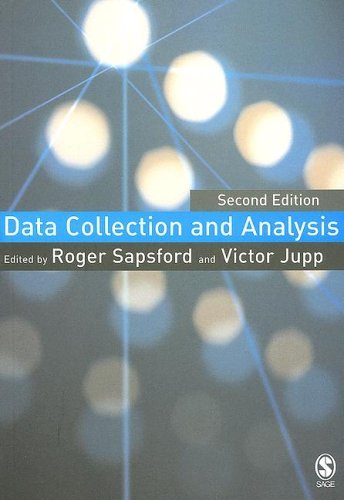Data Collection and Analysis 2nd Edition
Sapsford, Roger and Jupp, Victor (Editors)
Sage Publications, London
2006
0761943633 (pb)
 This second edition of Data Collection and Analysis contains thirteen chapters spread over four parts. It distinguishes itself from the plethora of research methods textbooks in its attempt to consciously go beyond the mere presentation of techniques of research. Without undermining the value of collecting and analyzing research data, it is intended for both readers and practitioners of research. In this sense, it offers help not merely to understand, evaluate and use evidence on the basis of available literature but also to do research. Indeed, the book has as its target audience students and researchers from a wide range of social science disciplines - sociology, education, social psychology, social work, criminology, health studies, government and politics and applied areas such as market research.
This second edition of Data Collection and Analysis contains thirteen chapters spread over four parts. It distinguishes itself from the plethora of research methods textbooks in its attempt to consciously go beyond the mere presentation of techniques of research. Without undermining the value of collecting and analyzing research data, it is intended for both readers and practitioners of research. In this sense, it offers help not merely to understand, evaluate and use evidence on the basis of available literature but also to do research. Indeed, the book has as its target audience students and researchers from a wide range of social science disciplines - sociology, education, social psychology, social work, criminology, health studies, government and politics and applied areas such as market research.
Yet, the book is meant more for undergraduate students than senior researchers. The organisation of the material reveals this preference of the editors. For example, each chapter ends with a 'running activity' to help students try out some of the techniques outlined. To be fair, each chapter also has a list of further readings for specialists to follow up.
Part I focuses on design issues delineating the basic logic of different kinds of research studies. The other items pertain to the techniques of data collection along with the technology of sampling. The two chapters included here are essentially concerned with validating evidence. Part II deals with the basic research activities of observation and asking questions. It enlists methods entailing various degrees of structure and also the use of documents. The four chapters collected here give a fair sense of distinction between primary and secondary data, direct and indirect uses of published statistics and database for research purposes, questionnaires, interview schedule. The primary motive seems to be to inculcate in practitioners of research finer points concerning reliability and validity of data.
Part III covers statistical analyses of data beginning with simple tabular and graphical presentation of data to some of the complex multivariate techniques using regression or analyses of variance. Interestingly, there is a chapter on the preparation of data employing qualitative analysis of text and interview transcripts from both an ethnographic and a critical point of view. The redeeming feature of the chapter on statistical analyses is that it does not assume any prior knowledge of statistical techniques or complex calculations – a claim that is generally made in all the textbooks but rarely achieved. This section offers techniques for getting the data into shape for analysis such as coding, data manipulation during analysis, missing values etc. Of the five chapters, there is an exclusive chapter devoted to the analysis of qualitative data. There is a chapter on discourse research as well which attempts to bring in much critical methodological thinking in accessible form. Part IV looks at the broad ethical and political issues that are important at all stages of research.
In its entirety, the volume turns out to be an accessible and informative textbook. However, as it happens with many textbooks in their zeal to be representative and up-to-date, it fails to accord just treatment to many intricate issues of theory and method. This book has hardly become richer by the inclusion of a new chapter on 'Research and Information on the Net' that appears to be a mere add-on. Likewise, the chapter on discourse analysis is too ambitious and fails to achieve much in the ten pages that have been assigned to it. Lastly, I think the editors/writers of research methods textbooks should consciously try to incorporate illustrations and examples that reflect the substantive realities in other parts of the world than their own. This will help readers, particularly from the non-Western world, to better relate to these textbooks.
Manish K. Thakur
Goa University

